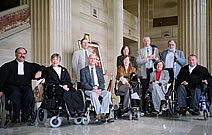Act Now

Empower U: Learn to Access Your Disability Rights Training on Canadian Human Rights, the Convention on the Rights of Persons with Disabilities (CRPD) and its Optional Protocol (OP) training aims to increase awareness of how to address discrimination using more familiar Canadian human rights laws such as Human Rights Codes and the newer international Convention on the Rights of Persons with Disabilities (CRPD). This is training for persons with disabilities by persons with disabilities. The training is part of a project funded by Employment and Social Development Canada and implemented by the Council of Canadians with Disabilities (CCD) in collaboration with Canadian Multicultural Disability Centre Inc. (CMDCI), Citizens With Disabilities – Ontario (CWDO), Manitoba League of Persons with Disabilities (MLPD) and National Educational Association of Disabled Students (NEADS). Read more.
Sign Up for our monthly digest
A monthly newsletter from CCD about what is happening in the community
Is Via About to Waste Tax Payer Dollars?
Related Documents
December 14, 2018
VIA RAIL SELECTS SIEMENS CANADA TO REPLACE ITS QUÉBEC-WINDSOR CORRIDOR FLEET
January 10, 2008
Reaction to Landmark Canadian Transportation Agency Decision: Disabled Canadians Jubilant to Have Transport Barrier Removed
March 23, 2007
Canadians With Disabilities Celebrate Supreme Court Decision
For Immediate Release
5 December 2000
Under the Canadian Transportation Agency (CTA), people with disabilities, the passenger rail industry and government hammered out a Code of Practice on accessibility for Canada's passenger trains. Despite having accepted this Code, VIA Rail is currently investigating the purchase of rail cars that are far from accessible. The Council of Canadians with Disabilities (CCD), a national advocacy organization of people with disabilities, is in the process of lodging a complaint with the CTA to ensure that VIA lives up to its responsibilities with regard to access. The CTA is the regulatory body that enforces Canada's safety and access rules for the transportation industry.
Rail cars that were originally destined to service the Channel Tunnel between Britain and France are being dumped onto the market; because deregulation of the air and rail industries has made rail service operators re-think their plans with regard to the Chunnel. The Federal Government has contributed $400 million to VIA so it can improve its services. When this funding was made available to VIA, Transport Minister Collenette wrote to VIA, emphasizing VIA's obligation to acquire accessible rolling stock. "Canadians with disabilities are worried that VIA is becoming a dumping ground for out-moded rail cars that European operators find redundant," states Eric Norman, CCD's Past Chairperson. "We don't believe that $400 million of taxpayers hard earned cash should be wasted on out-of-date obsolete coaches which do not meet the needs of Canada's traveling public. Canada must not become a third world dumping ground."
The rail cars being considered by VIA take a segregated approach to the transportation issues of people with disabilities. The only feasible option for a wheelchair user is the wheelchair accessible sleeper unit, which is only semi-accessible. The Coach car has three washrooms but none are accessible to a wheelchair user. A guide dog user traveling in the Coach car would have to decide between traveling with their guide dog or hand luggage because there is no room for both. The regular sleeper car is also not accessible.
"The designers of these cars were following a segregation model. They thought it was acceptable to hive off wheelchair users in separate quarters," states Pat Danforth, Chairperson of CCD's Transportation Committee. "Our willingness to accept segregation ended a long time ago." CCD has reminded the Minister of Transport and VIA Rail of the access commitments that have been made to Canadians with disabilities with regard to accessible rail travel.
-30-For more information, contact:
Laurie Beachell, National Coordinator, 514-842-4881 (Until Thurs. a.m.; 204-947-0303 (After Thursday pm );
Eric Norman, CCD Past Chairperson, Tel: 709-256-8630;
Pat Danforth, Chairperson CCD Transportation Committee, Tel: 250-383-4443;
David Baker, Legal Counsel, Tel: 416-539-0226

CCD wins VIA Rail case at the Supreme Court of Canada on March 23, 2007.
